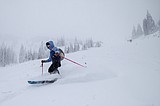Ridge Fire provides opportunity for research as it burns experimental forest
KATE HESTON | Hagadone News Network | UPDATED 2 years, 4 months AGO
Kate Heston covers politics and natural resources for the Daily Inter Lake. She is a graduate of the University of Iowa's journalism program, previously worked as photo editor at the Daily Iowan and was a News21 fellow in Phoenix. She can be reached at [email protected] or 406-758-4459. | August 25, 2023 12:00 AM
Fire is burning western larch in what amounts to an outdoor laboratory in the Flathead National Forest. When the flames are extinguished and the smoke clears, the fire will provide the opportunity for scientific study.
The lightning-caused Ridge Fire along the Hungry Horse Reservoir is burning in a portion of the Coram Experimental Forest and the Coram Research Natural Area, both of which have been set aside for researchers to study western larch regeneration and management.
The burning of the experimental forest and the natural area are prime chances to study the effects of fire on controlled or constant western larch populations. The fire, therefore, is unique, according to Kira Powell, the public affairs specialist for the Flathead Forest.
“This one is extra interesting,” Powell said.
The Coram Experimental Forest is partially burning. Overall composed of 7,500 total acres and established in 1933 through an agreement with the Rocky Mountain Research Station and the Flathead Forest, the Ridge Fire has burned in its southern area.
Research has historically centered around the regeneration, ecology and management of the species. Western larch is a tree species that regenerates well in the exposed soil and sunny conditions that are typical after a fire or other disturbances, making it important for reforestation efforts, according to the Forest Service.
The experimental forest is used to study the ecology, silviculture and ecological dynamics of western larch in a mixed forest, be it through regeneration or cone and seed development studies or determining the amount of productive wood harvest.
Fires are to be suppressed in the Coram Experimental Forest, where forest management occurs demonstrating the long-term effects of those choices.
In the southeastern corner of the experimental forest sits the Coram Research Natural Area, which was established in 1988. The piece of land is over 800 acres full of old-growth western larch and, contrary to the experimental forest, forest management practices don’t occur there. Rather, the area is solely monitored to observe how western larch live naturally.
A part of the natural area is also on fire.
The research natural area is set aside for its ecological qualities with the intention of preserving natural ecological processes and natural succession, including fire, with limited human influences.
“The tenants of the [natural area] are allowing fire and natural processes to occur only to a point…” Powell said. “It's not that fire can not be suppressed in those areas.”
The Ridge Fire is a full suppression fire in all zones due to its close proximity to structures and its intensity, so to maintain the natural area firefighters are minimizing their impact on the ground when performing suppression techniques. For example, they are using a hand line rather than heavy equipment to keep things as natural as they can be, Powell said.
“We try to be mindful with minimal impact and suppression tactics whenever possible,” said Andy Huntsberger, a fire management officer for the Hungry Horse-Glacier View Ranger District.
Research natural areas are within federal forest plans, but have specific designations to allow for the opportunity to study the forest without human interference.
Firefighters observe the scale of the fire and respond accordingly, Jake Cogle, one of the incident commanders on the fire, said. Since suppression needs to occur, they maintain minimal suppression efforts that won’t heavily impact the ground in the natural area.
“We still want to suppress the fire,” Cogle said, “...but we try to keep that natural.”
After the fire is out, scientists will examine how untouched, old western larch react to natural fire.
It's important to follow rules when fighting fires, Huntsberger said. If there wasn’t a rule book, fire efforts would trash the ground and wouldn’t work well. Hence the designation of the natural area, and the difference in approach to it, are valued.
Reporter Kate Heston can be reached at [email protected] or 758-4459.
ARTICLES BY KATE HESTON

Veteran-owned mobile boat repair service anchors down in the Flathead Valley
The Kramers launched Flathead Mobile Marine to use their skills — they have decades of experience performing routine maintenance checks on a variety of boats as well as working with engines and electrical systems — and help boaters in the community.

With ski season near, resort reaches deal with staff
After 18 months of negotiations, Whitefish Mountain Resort executives and the resort’s ski patrol union are finalizing a one-year contract for the upcoming season.

Trapped in a car wreck, Woods Bay woman credits teens with saving her life
Driving home from a quilting event in Bigfork in September of last year, Carol Martin remembered that the sky was clear, the sun was shining, and she had a headache.

